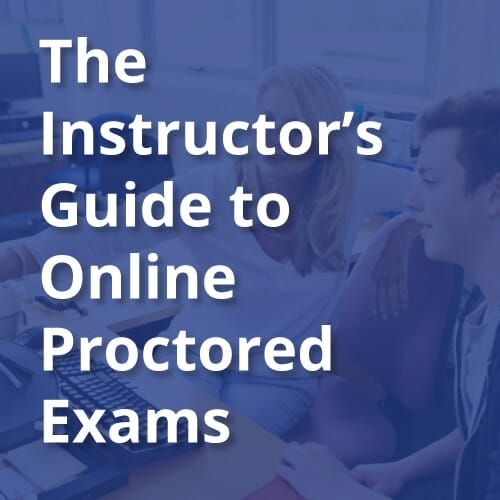As more schools shut down and start moving learning online due to the COVID-19, it’s important to know that there are solutions out there for ongoing education and helping students continue acquiring the skills they need.
Click the button below to see how you can implement online proctoring in 2 days to help protect exams and support students during COVID
Here are some common questions that people have as they convert their homes into an adequate learning space:
What if students don’t have their own computers or webcams?
If your institution has not implemented a 1:1 student-to-device program, it can be hard to find a resource for students now. Unfortunately, laptops are one of those items people are rushing to buy worldwide due to the increase in work from home workers as well as learners. Check with local nonprofits and businesses that may be ramping up programs that provide laptops during this time. Here is a link to an article that lists several organizations and creative ideas to find a low price or free resources.
What if students don’t have adequate internet access?
Maintaining digital equity for all students is a major hurdle for most college campuses moving learning online right now because if they don’t have access to the internet during the current global pandemic, it will be impossible for them to learn. With shelter in place requirements in place or coming, even the public library may not be an option for learning for quite some time.
Here are some suggestions for how students can gain access to the internet:
- Spectrum is offering free broadband and Wi-Fi internet access for 60 days to students impacted by the coronavirus shutdown. Charter Communications, Spectrum’s parent company, announced Friday that beginning March 16, it will make its services available for free for 60 days to households with K-12 and/or college students who don’t already have internet through the company. Installation fees will also be waived for new student households. It also said it would open its Wi-Fi hotspots for public use.
- Comcast is also making it easier for low-income families who live in a Comcast service area to sign up by offering new customers 60 days of free Internet Essentials service, which is normally available to all qualified low-income households for $9.95/month. The company is also increasing internet speeds for the Internet Essentials service from 15/2 Mbps to 25/3 Mbps for all new and existing customers, which will be the speed of the service going forward.
- More vendors may be offering access as the pandemic response matures.
What if I or my students lose the internet? Will their exam answers be lost?
Honorlock offers 24/7 technical support 365 days a week to help students with issues as they take their exam, easily accessible through an Honorlock support menu available on their screen. Honorlock also monitors additional activity like someone trying to leave the test session, copy/paste questions, or open a new browser. We also have encrypted protocols in place to save work, view the test taker’s answers, and allow the proctor access to review exam session videos.
What is Honorlock’s availability like during the coronavirus crisis if we launch and have issues?
As educational institutions transition to moving learning online during the current global pandemic, we anticipate an uptick in demand for our services. Our HonorSquad continues to closely monitor the COVID-19 situation, focus on best practices and plan ahead. We’ve contacted AWS (Amazon Web Services) to obtain extra capacity, talked to third party video conferencing vendors to ensure that they understand our demand, and increased our staff. More simply put, we’re preparing as if it was finals week. For more information, check out our Our Pledge To You During Coronavirus and feel free to email us (support@honorlock.com), or launch a live chat at honorlock.com.
What does Honorlock do exactly?
If you are in the process of quickly moving your instructors, students, and staff to an online platform to minimize any downtime with their continued education, keep in mind that Honorlock is a safe and efficient way to facilitate your exams.
Honorlock provides on-demand proctoring services that do not require advanced scheduling or bulky software downloads. Because maintaining academic integrity is of the utmost importance to us, we’ve also patented a one-of-a-kind mobile device detection system.
Honorlock’s innovative and exclusive online proctoring features include:
- Search and Destroy: To help deter cheating, we employ our proprietary test bank removal service that actively searches the Internet and destroys any unauthorized copies of your test questions. In an online world, it’s far too easy to share and find test answers. We put a stop to this by immediately filing DMCA copyright takedown notices if we find any copycat test information.
- Multi-Device Detection: Honorlock is proud to have the only technology that can detect multiple devices that may be used during test-taking to try to find answers. Our system even takes screenshots to help prove that attempted cheating may be happening during an exam.
- Voice Detection: Faculty has told us that online testing services that send voice detection alerts tend to be over flagged, putting unnecessary stress on students. Honorlock reduces the number of inappropriate flags with its proprietary system. The voice detection service even goes beyond that by listening for keywords that students may be using to try to cheat, like flagging words such as “OK Google” and “Hey Siri”.
- Live Pop-In: Honorlock offers the only Live Pop-In system that combines automation and live proctoring by prompting test proctors to pop into the exam if there’s any suspicious activity going on.
How to get started transferring courses online ASAP with Honorlock
The urgency to get students transitioned into an online learning environment has never been greater. If you are a school or administrator that needs a safe, secure robust proctoring system right away, Honorlock can help. To get started, simply go to this page and follow these steps:
Step 1: Sign a condensed 2-page agreement that makes it easy to get up and running while eliminating liability threats.
Step 2: Fill out a simple order form (Honorlock charges $5 per exam) that will only be billed after the impact of the coronavirus has lessened.
Step 3: Go live with same-day integration and training.
Resources for Further Reading
- https://honorlock.com/blog/covid-19-is-here-now-go-wash-your-hands/
- https://www.iste.org/explore/10-strategies-online-learning-during-coronavirus-outbreak
- https://honorlock.com/blog/hats-off-to-higher-ed/
- https://www.usatoday.com/story/news/education/2020/03/14/coronavirus-college-closings-flight-spring-break-2020/5043547002/
- https://www.businessinsider.com/science-based-strategies-to-help-you-deal-with-coronavirus-anxiety-2020-3













